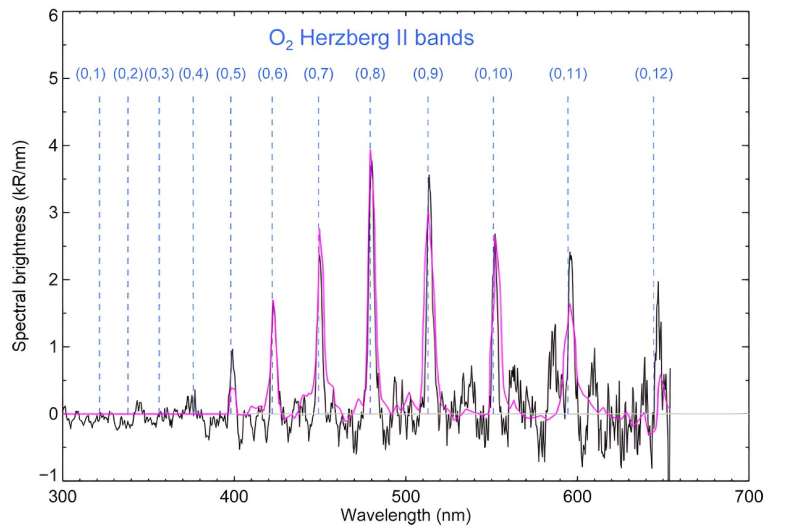This article has been reviewed according to Science X's editorial process and policies. Editors have highlighted the following attributes while ensuring the content's credibility:
fact-checked
peer-reviewed publication
trusted source
proofread
Glow in the visible range detected for the first time in the Martian night

A scientific team led by researchers from the Laboratory for Planetary and Atmospheric Physics (LPAP) at the University of Liège (BE) has just observed, for the first time, lights in the night sky over Mars using the UVIS-NOMAD instrument on board the Trace Gas Orbiter (TGO) satellite of the European Space Agency (ESA).
This instrument is part of the NOMAD spectrometer suite developed at the Royal Institute for Space Aeronomy in Uccle, and tested and calibrated at the Liège Space Centre. It was inserted into a circular Martian orbit at an altitude of 400 km in 2008.
Initially designed to map the ozone layer surrounding the planet in the ultraviolet, UVIS-NOMAD covers a spectral range extending from the near ultraviolet to red. For this purpose, the instrument is usually oriented towards the center of the planet and observes sunlight reflected by the planetary surface and atmosphere.
"Based on a proposal from our laboratory, the instrument was oriented towards the limb of the planet in order to observe its atmosphere from the edge," explains Jean-Claude Gérard, planetologist at ULiège. "Back in 2020, we were already able to detect the presence of a green emission between 40 and 150 km in altitude, present during the Martian day. This was due to the dissociation of the CO2 molecule, the main constituent of the atmosphere, by ultraviolet solar radiation."
A long journey for oxygen atoms
The TGO satellite, when observing the atmosphere at night, has just detected a new emission between 40 and 70 km altitude.
"This emission is due to the recombination of oxygen atoms created in the summer atmosphere and carried by the winds towards the high winter latitudes," explains Lauriane Soret, a researcher at LPAP. "There, the atoms recombine on contact with CO2 to reform an O2 molecule in an excited state that relaxes and emits light in the visible range."
This light emission is concentrated in the polar regions to the north and south, where the oxygen atoms converge in the downward branch of the gigantic trajectory from the opposite hemisphere. The intensity of the emission is high, in the visible range. This process seems to be reversed every half Martian year, and the luminosity then changes hemispheres.
A similar emission was analyzed on Venus by the same team using images from the Venus Express satellite. On Venus, the atoms travel from the sunlit side to the dark side where they emit the same glow as on Mars.
LPAP researchers played a key role in these observations. After highlighting the presence of a layer of green light surrounding the planet on the day side, they identified the night-time emission.
"The study will be continued during the TGO mission and will provide us with valuable information about the dynamics of the Martian upper atmosphere and its variations over the course of the Martian year," continues Lauriane Soret. "We have noticed that another ultraviolet emission due to the nitric oxide (NO) molecule is also observed by UVIS in the same regions. Comparing the two emissions will enable us to refine the diagnosis and identify the processes involved."
The NO molecule also emits light when oxygen and nitrogen atoms recombine. As with the radiation from the O2 molecule, the atoms are formed in sunlight, transported by the winds to the other hemisphere and recombine during the downward motion in the polar regions.
"These new observations are unexpected and interesting for future journeys to the Red Planet," says Jean-Claude Gérard. "The intensity of the night glow in the polar regions is such that simple and relatively inexpensive instruments in Martian orbit could map and monitor atmospheric flows. A future ESA mission could carry a camera for global imaging. In addition, the emission is sufficiently intense to be observable during the polar night by future astronauts in orbit or from the Martian ground."
Benoit Hubert, researcher at LPAP, concludes, "Remote sensing of these emissions is an excellent tool for probing the composition and dynamics of Mars' upper atmosphere between 40 and 80 km. This region is inaccessible to direct methods of measuring composition using satellites."
The research was published in Nature Astronomy.
More information: Gérard et al, Observation of the Mars O2 visible nightglow by TGO-NOMAD, Nature Astronomy (2023). DOI: 10.1038/s41550-023-02104-8
Journal information: Nature Astronomy
Provided by University de Liege




















